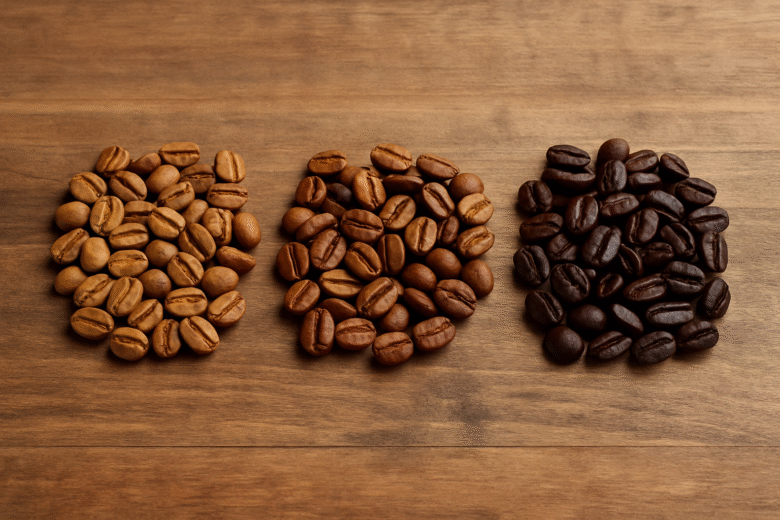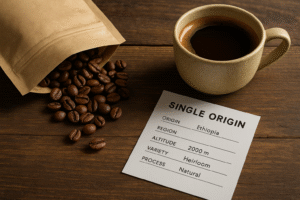When you pick up a bag of coffee, one of the first things you’ll see is the roast level: light, medium, or dark. While many people choose based on habit or preference, understanding roast profiles opens up a world of flavor exploration.
Roast level doesn’t just change the color of the bean—it transforms the flavor, aroma, acidity, body, and caffeine content of your brew.
Whether you’re new to coffee or want to fine-tune your palate, knowing the basics of each roast will help you select the right beans for your taste and brewing method.
This guide breaks down the characteristics of light, medium, and dark roasts, helping you make better choices at the café or when shopping for beans.
What Happens During Coffee Roasting?
Roasting is the process of applying heat to green coffee beans until they reach a desired flavor and color profile. The beans go through a series of chemical reactions that transform their sugars, acids, and structure.
As beans roast:
- Moisture evaporates
- Acidity and complexity change
- Oils begin to surface (at darker levels)
- Flavor compounds develop and degrade
Roasters listen for “cracks”—audible popping sounds that signal stages of development. The first crack indicates a light roast, and the second crack happens closer to a dark roast.
Each roast level creates a different balance of sweetness, body, acidity, and bitterness.
Light Roast: Bright and Complex
Light roasts are roasted to just after the first crack. They retain most of the bean’s original character and natural flavors.
Characteristics:
- Light brown color
- Dry surface (no visible oil)
- High acidity and clarity
- Fruity, floral, and tea-like notes
- Lighter body
- More caffeine than dark roasts (by weight)
Best for:
Single-origin beans where the goal is to highlight terroir. Ideal for pour-over, AeroPress, and cold brew.
Popular names:
- Light Roast
- Cinnamon Roast
- Half City Roast
- New England Roast
Taste Example:
An Ethiopian Yirgacheffe light roast might taste like jasmine, lemon, or bergamot tea.
Medium Roast: Balanced and Smooth
Medium roasts are taken a bit further past the first crack, often stopping before or just at the second crack. This level strikes a balance between origin flavor and roast character.
Characteristics:
- Medium brown color
- Slightly richer aroma
- Moderate acidity and body
- Notes of chocolate, nuts, and fruits
- Slight sweetness and balanced finish
Best for:
Daily drinkers, espresso blends, and those who enjoy complex but approachable coffee. Works well for drip, French press, and espresso.
Popular names:
- City Roast
- American Roast
- Breakfast Roast
- Medium Roast
Taste Example:
A Colombian medium roast may have hints of cherry, caramel, and milk chocolate.
Dark Roast: Bold and Intense
Dark roasts go through or beyond the second crack. At this point, the roast profile dominates the origin flavors. The beans develop a deep, smoky flavor, and oils often appear on the surface.
Characteristics:
- Dark brown to black color
- Oily surface
- Low acidity
- Full body and bitterness
- Notes of smoke, cocoa, or toast
- Roast-forward flavor
Best for:
Espresso, lattes, or anyone who prefers a strong, bold brew. Also suitable for moka pot or cold brew.
Popular names:
- Full City Roast
- French Roast
- Italian Roast
- Espresso Roast
- Dark Roast
Taste Example:
A Sumatra dark roast might offer earthy, smoky, and spicy tones with minimal brightness.
Caffeine Content by Roast
There’s a common myth that dark roasts have more caffeine. The truth is a bit more nuanced.
By weight: Light roasts have slightly more caffeine because they retain more mass during roasting.
By scoop: Dark roasts may have slightly more caffeine, as the beans expand and are less dense—so a scoop holds more beans.
The difference is minimal and unlikely to affect most drinkers, but worth noting if you’re sensitive to caffeine.
How to Choose the Right Roast for You
Your perfect roast depends on your taste preferences, brewing method, and mood.
Choose light roast if you like:
- Bright, fruity, or floral flavors
- High acidity and delicate profiles
- Single-origin complexity
Choose medium roast if you prefer:
- Balanced acidity and sweetness
- Round body with chocolate or nutty notes
- Versatility across brewing methods
Choose dark roast if you enjoy:
- Bold, smoky, or bitter flavors
- Full body with low acidity
- Strong coffee that pairs well with milk or cream
You can also experiment with different roasts of the same origin to compare how roast level changes the flavor.
Roast Level and Brewing Method
Certain brew methods complement specific roasts better than others.
Light Roast:
- Best for pour-over, Chemex, AeroPress
- Not ideal for espresso unless dialed in carefully
Medium Roast:
- Great for drip, French press, and espresso
- Suitable for almost any method
Dark Roast:
- Best for moka pot, espresso, and cold brew
- Often too intense for pour-over
Adjust your grind size and brew time depending on roast level. Light roasts often require finer grinds and longer extraction.
Roast Date and Freshness
Roast level also affects how long coffee stays fresh.
- Light roasts retain flavor longer but may need a few days to “rest” before brewing
- Medium roasts are stable and versatile
- Dark roasts can go stale faster due to surface oils
Buy in small batches and use within 2–3 weeks of roast date for peak flavor. Store in an airtight container away from heat and light.
Common Mistakes When Choosing Roast
- Choosing only by color or name: Terms like “breakfast blend” or “house roast” vary by brand
- Assuming dark roast means stronger coffee: Strength depends more on brew ratio than roast level
- Ignoring roast freshness: Old coffee loses complexity, regardless of roast
- Over-roasting single-origins: Too dark and you lose the unique characteristics of origin
Ask your roaster for guidance if you’re not sure what to choose. Many shops offer samples or tasting flights.
How Roasters Decide on Roast Level
Roasters evaluate a coffee’s origin, density, moisture, and flavor potential before deciding how to roast it.
- Delicate, floral beans may shine at light roasts
- Chocolatey or nutty beans do well at medium
- Beans with earthy or bold tones may benefit from a darker roast
Artisanal roasters use sample roasting and cupping to fine-tune each coffee’s profile.
That’s why you might find two roasters offering the same origin at different roast levels—each sees something different in the bean.
Conclusion: Roast Levels Are Your Flavor Key
Light, medium, and dark roasts each offer a unique flavor experience. Learning the differences helps you discover what you enjoy most and why.
Don’t limit yourself to one style—try a variety of roast levels, brewing methods, and origins to broaden your palate.
Next time you buy coffee, go beyond the label. Choose a roast that suits your brew method, matches your taste, and invites you to explore more of what coffee has to offer.

Marcio Luzardo is a coffee enthusiast and the voice behind Tudo Viraliza. With a passion for turning curiosity into practical knowledge, he shares easy-to-follow tips, guides, and insights to help readers enjoy better coffee every day. When he’s not writing, Marcio is exploring new brewing methods or diving into the rich stories that connect coffee to culture, lifestyle, and wellness.



